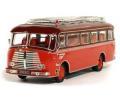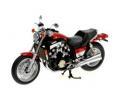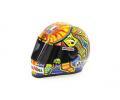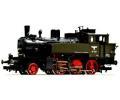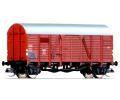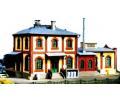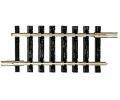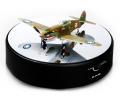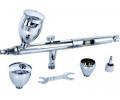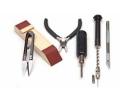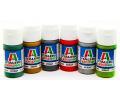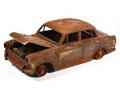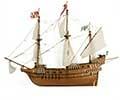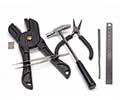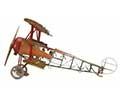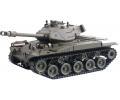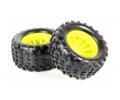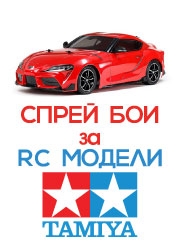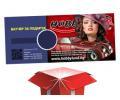Подробности
Умален модел на автомобил, изработен от метал /Die-cast/ в мащаб 1:18, произведен от CMC .
Моделът е точно умалено копие на реалния автомобил, подходящо за колекционери. Ръчно изработен.
Състав: метал и пластмаса
PRODUCT DESCRIPTION
For the upcoming 24 Hours of Le Mans in 1938, “Alfa Corse,” the newly-founded Alfa Romeo racing department, was up in arms. They were determined to win! To this end, an 8C 2900 B was developed that was fitted with a coach-built body and a high-performance engine.
Alfa Romeo contracted the renowned coachbuilder Touring to customize a closed-top body (Berlinetta) based on its famous expertise in aerodynamic styling and Supperleggera or lightweight construction. This resulted in a stunningly beautiful and futuristic-looking car, fully equipped to take on the race.
The veteran drivers Raymond Sommer and Clemente Biondetti teamed up to race the new car with starting number 19 at the Sarthe. Never before in Le Mans’ racing history had there been such a dominant car as the 8C 2900 B Speciale would turn out to be.
In the 20th hour, the Alfa duo was leading by 11 laps or approximately 160 km, when their car, flying at full speed, had its right front tire burst.
Raymond Sommer managed to steady the car, stay on the track, and make a pit stop. It was found that the ruptured tire had also damaged the engine mounting bracket, and there was an oil leakage. Not ready to give up yet, Clemente Biondetti resumed the race. But only two laps later, a broken valve added the last straw, forcing the team to resign to its fate.
A seemingly certain victory for the Alfa slipped through their fingers in a matter of seconds. Le Mans 1938 was the only race in which the 8C 2900 B Speciale with a Superleggera body made an appearance.
TECHNICAL DATA OF THE ORIGINAL VEHICLE
Maximum output: 220 PS bei 9.000 U/min
Displacement: 2.905 (2.927) ccm
Top speed: 245 km/h
Bore x stroke: 68 x 100 mm
Wheel base: 2.799 mm
Track front / rear: 1.349 / 1.349 mm
Dear Sir/Madam,
This is to provide you with further background information about Alfa Romeo’s glorious past in the 1920s and 1930s. If you have been following CMC’s line of vintage car models that feature extraordinary quality and craftsmanship, you don’t want to miss these new replicas of the exclusive brand of Alfa Romeo. To bring historic vehicles back to life on your shelves, it makes good sense to integrate their replication with CMC’s extraordinary craftsmanship, authentic detailing, and use of choice materials. Each of the Alfa Romeo replicas has started as a challenge for meticulous development at CMC and is completed as a new trophy for the CMC team, which has fascinated customers and fans with one amazing model after another continuously.
Here is how things all started with Alfa Romeo…
In the year 1906, Alexandre Darracq decided to introduce a new line of cars on the Italian market, and he built a factory to assemble them in Naples. A sales and service department was set up in Milan, the industrial centre of northern Italy. The launch of Darracq’s cars, however, did not turn out to be a success story, and in 1909 Darracq sold his business to a newly-formed company, Anonima Lombarda Fabbrica Automobili, abbreviated as A.L.F.A. To cater to the tastes of the Italian market, the new company overhauled the design of Darracq cars and introduced them under its namesake brand “ALFA.”
In 1911, Nicola Romeo, an industrialist from Milan, took control of the company and, shortly after World War I, turned it into a public company, the Alfa S.p.A., which was changed to Alfa Romeo subsequently. From 1920 onwards, the name “Romeo” was incorporated into the company logo, and a four-leaf clover was also added to the company trademark.
During the 1920s and early 1930s, the reputation of Alfa Romeo was comparable to that of Bugatti, which was widely acclaimed at the time. Both makes were synonymous with the most exciting, beautiful, and fastest sports cars of the era. The Bugatti models were born of individual creation by a master, such as Ettore Bugatti, the great “Le patron,” and later his son Jean. Each new Bugatti was first crafted as if it were a work of sculpture: the designer-sculptor “chiselled away” what was undesirable little by little, piece by piece until every part of the car looked breath-takingly elegant. In contrast, the development process was different at Alfa Romeo, where each new model grew out of collective efforts made by a team of talented engineers and craftsmen. Of course, ingenious virtuosos like the legendary Vittorio Jano were granted a greater freedom of creative expression, which made itself felt in the cars that rolled off the factory. The Alfa Romeo models were just as marvellously stylish as their famous counterparts from Molsheim. They were also easier to drive and negotiated curves at a greater speed with less noise and demand of efforts on the pilot. Vastly superior to their French competitors, they also started readily in winter months.
Alfa’s racing successes during this period were attributed to the development of four famous series: P2 (P3), 6C 1500-1750, 8C 2300, and 8C 2900B. They served to establish Alfa as a leading automotive make during the 1930s.
At the 1924 Grand Prix, Alfa Romeo introduced its newly-developed P2, a 2-litre straight-8 race car with double overhead camshafts, and it won a sensational victory on debut. This historic vehicle would maintain its winning record continually to become an iconic car of the 1920s, and it exerted a profound impact on the development of GP race cars. The P2 remained almost unbeatable during this period. An uprated P3 took over during the 1930s, and with Nuvolari at the wheel, it also scored one victory after another in GP racing.
Designed after the successful P2 by ingenious Vittorio Jano, the legendary 6C series was launched in 1927. It began with the 6C 1500 and ended with the 6C 1750 GS, otherwise known as the Gran Sport version. 1929 saw a 6C 1750 finish first at Mille Miglia. In 1930 Nuvolari drove his 6C 1750 GS to championship at Mille Miglia. In the contest of the Irish Tourist Trophy, Nuvolari, Campari and Varzi from the Alfa Romeo team braved the torrential rain to finish 1st, 2nd, and 3rd.
The 1750 was the crown jewel of the 6C series. Only the 24-hour endurance race of “Le Mans” proved to be too much for it.
At the end of 1930, the 6C 1750 was succeeded by the 8C 2300, a model that would become just as victorious and famous as its predecessor, if not more. At first glance, it looked like an enlarged 6C 1750, but under the elongated bonnet was a straight-8 engine with a side-mounted compressor rather than a frontal one, as in the 6C 1750. The 8C 2300 was a power house. Its racing version was bored out to 2.6 litres, delivering an output of 165 hp and a speed up to 200km/hr.
In the early thirties, the 8C 2300 was the king of the racetrack. In Grand Prix races, they outperformed Bugatti’s to win the title repeatedly until the Silver Arrows of Mercedes and Auto Union came on the scene. In retrospect, the 8C 2300 won the 24 Hours of Le Mans in 1931, 1932, 1933 and 1934. The years 1932 and 1933, in particular, witnessed the 8C 2300 score a sweeping victory at Le Mans twice, claiming the first, second, and third places each time. Meanwhile, the 8C 2300 also dominated the prestigious Mille Miglia race year after year.
By the mid-1930s, however, the glory of Alfa Romeo was in danger of fading away. Its rigid axial engineering and cable brakes were getting outdated and could no longer measure up to the latest advance of technology.
To catch up, Alfa Romeo developed in 1937 the 8C 2900B, an entirely new model. Powered by a straight 8-cylinder engine, it boasted an output of 180 hp that could sustain a speed of 200km/hr.
The vehicle adopted an all-round independent suspension, unbelievably reliable hydraulic brakes, and other cutting-edge features that greatly enhanced its maneuverability, velocity, and safety. Only one thing was missing -- the old Alfa aerodynamic styling. Many people thought the 8C 2900B was too big, too “plush,” and too much of a business-like roadster. In spite of this, the new model exhibited a spectacular capacity of triumphing on racetracks. The 8C 2900B clinched the 1st, 2nd, and 3rd places at the 1938 Mille Miglia. In the course of his successful run for the championship, Clemente Biodetti also set up an amazing new world record, covering the 1635 km of the race at an incredible speed averaging 135km/hr.
The newly-founded racing department “Alfa Corse” was now highly motivated to do well in the upcoming 24-hour endurance race of Le Mans, and they must get a race car ready that was good enough to compete and win at Le Mans. It occurred to them that an 8C 2900B fitted with a coach-built body and a more powerful engine was all they would need.
The renowned coachbuilder Touring was contracted to build for this car a close-top (Berlinetta) body based on its patent expertise that features an aerodynamic contour and lightweight construction known as “Superleggera.” The result was a breathtakingly beautiful and futuristic-looking race car. Its two front fenders were integrated into a wholesome configuration of the body. Behind the front wheels were two removable panels for quick access to the engine.
Equipped with two Roots superchargers, the 2.9-litre eight-cylinder inline engine was capable of yielding an improved maximum output of 220 hp and a top speed of 245km/hr.
A veteran team for long distance racing, Raymond Sommer and Clemente Biondetti took off with starting No. 19 at Sarthe. In Le Mans’ racing history, never had a vehicle obtained such a dominant and superior lead as the 8C 2900B Speciale with the Touring Berlinetta body did that day.
In the 20th hour of the race, the 2900B was leading by 11 laps or 160 km ahead of the next best competitor and was seemingly safe from any challenge, when its right front tire burst. Raymond Sommer managed to bring the car under control and stay on the track before making a pit stop. It was found that the ruptured tire had caused damage to the engine mounting bracket, and there was an oil leakage. Refusing to give up, Clemente Biondetti drove the car for two more laps until a damaged valve compelled them to call quits.
Such is the story of how the longest lead of all times in Le Mans’ history came to a disastrous end, and why an apparently certain victory got lost. The Alfa Romeo 8C 2900B that raced at the 1938 Le Mans was the only one of its kind that was fitted with a Touring coach-built body.
After World War II, the vehicle changed hands several times, and it eventually wound up in England. In the 1980s, the Alfa Romeo Storico Museum brought it back home to Italy. After a thorough restoration, the vehicle was reinstated in an optimal running condition.
There is no doubt that the 8C 2900B is one of the world’s most valuable pre-war cars, and as an epitome of Alfa Romeo’s glorious racing history, it is also a priceless asset to the Alfa Romeo Storico Museum.
As a manufacturer of high-end model cars that is licensed to replicate the 8C 2900B, CMC would like to acknowledge the generous support and advice of the Alfa Romeo Storico Museum in the development of 8C 2900B replicas. Sincere thanks are also due to the director and staff of the Alfa Romeo Storico Museum in Arese, Italy, who have made the aforementioned support and advice available to us.
CMC GmbH & Co. KG
Classic Model Cars
Допълнителна информация
| Каталожен № | M-111 |
|---|---|
| Каталожен № на производител | M-111 |
| Наличност | Изчерпан |
| Цвят | Червен |
| Мащаб | 1:18 |
| Производител | CMC |
| Марка | ALFA ROMEO |
| Серия | Не |
| EAN | Не |
| Състав | Метал и пластмаса |
| Епоха | Стари автомобили (1920-1942) |
| Възраст | Не се препоръчва за лица под 14 години. |
Споделете Вашето мнение
Само регистрирани потребители могат да пишат отзиви. Моля, влезте в профила си или се регистрирайте




